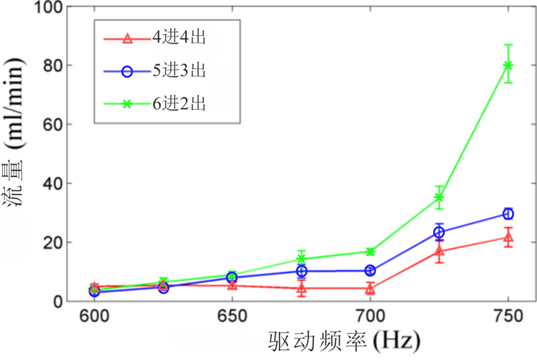Suppressing the generation of cavitation by increasing the number of inlet check valves in piezoelectric pumps
Yang Ye, Jian Chen, QiaoSheng Pan, ZhiHua Feng.
Link: https://www.sciencedirect.com/science/article/pii/S0924424718319265
Abstract
Cavitation is a serious constraint on micropumps. A method in which the number of inlet valves is increased to raise the pump chamber pressure is proposed to suppress the generation of cavitation in micropumps. The simulation shows that as the number of inlet valves in the pump increases, the pressure in the pump chamber rises during the absorbing phase. When the pump is designed with 6 inlet and 2 outlet valves, the pressure in the pump chamber can increase above the saturated vapor pressure, thereby the generation of cavitation can be suppressed. Experimental data show that the flow rate of the pump using 6 inlet and 2 outlet valves can reach four times that of the pump using 4 inlet and 4 outlet valves. Experiments and simulations results show that increasing the number of inlet valves can effectively suppress the generation of cavitation and improve the efficiency of micropumps.
摘要
作为高流速下对压电往复泵性能的一个严重约束,空化现象引起了许多研究者的注意。空化是指蒸汽气泡在低压条件下形成及生长,然后在高压条件下内爆坍塌的现象。在压电往复泵中,空化的影响会与泵腔隔膜的机械振动相结合。因此,考虑到隔膜的高频振荡速度,空化会对压电往复泵产生实质性的影响,包括改变其流动特性。
通常,压电往复泵中的空化现象开始于吸入阶段的初始阶段,因为此时泵膜的加速度最大并且泵腔中的压力处于最小值。入口阀的开启会因惯性而延迟,液体的流入也会发生一定的时间延迟。在吸入阶段开始时,泵膜移动引起的液体流动高于来自入口侧的液体流动。这导致泵腔的体积膨胀,压力降低,当最终低于饱和蒸汽压力时,在泵腔中会发生空化现象。由于气体体积膨胀引起的这种空化会在刚性表面附近形成许多空腔,例如在泵膜和单向阀表面处。一旦泵腔中的压力低于饱和蒸汽压力,入口侧的流体流动就不再与泵腔内的运动相关联。进水管中的液体将与泵中的液体分离,并遵守其它物理定律。这将大大降低泵的吸入效率,从而导致泵性能下降。
本文提出了通过增加进水单向阀的数量来研究抑制空化现象的方法。详细研究了改变进水单向阀数量对泵腔压力和泵流量输出的影响。仿真结果表明,当进出阀的比例为6:2时,泵腔在吸入阶段工作时泵腔内和进水阀处的压力大大提高,高于饱和蒸汽压力,最终达到抑制空化产生和改善泵的工作效率的目的。实验结果表明,使用6进水阀2出水阀的流量明显大于使用4进水阀4出水阀的泵。当驱动频率为750Hz驱动电压为200Vpp时,使用6进2出阀的流量是使用4进4出阀的4倍。

图表 1使用三种单向阀组的泵腔压力仿真模型:(a)4进4出,(b)5进3出,和(c)6进2出。(d)三个泵腔内的压力与饱和蒸气压之间的比较

图表 2当驱动电压为200Vpp时,三种泵(即4进4出,5进3出和6进2出单向阀组)的流量与驱动频率的关系







